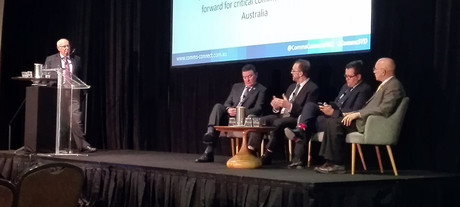Industry insights shared at Comms Connect

A fascinating array of presentations and exhibits was featured at Comms Connect Sydney.
This year’s Comms Connect Sydney conference and exhibition was held at a new venue, Rosehill Gardens (next to the racecourse) in western Sydney. There was a general consensus that the venue was far superior to the location used in previous years, and it was great to see the exhibition hall humming all day long.
There was a full program of speaker sessions, workshops and panels. Your author couldn’t attend all of the sessions (as many were run in parallel), but here are some of the highlights from those I was able to attend.
Bill Schrier, who had just flown in from the US, gave us an update on FirstNet and the kinds of capabilities it will provide to first responders as the system matures. Ian Miller, who had recently attended the PCSE conference in Brussels, presented an overview of European public safety communications developments and their possible relevance to the Australian situation.
Giles Tanner from the ACMA gave us a good overview of the role and daily work of the Authority, and of some of the developments on the horizon as it grapples with the effect of new technologies and changes coming up in the new radiocommunications legislation. He also spoke at length about the ways in which it seeks to engage with the communications industry, and especially with bodies such as ARCIA. See the main feature article in this issue for an edited version of his presentation.
Surf and sea were on the agenda as Marcus Grinblat spoke about the history and operations of the Australian Volunteer Coast Guard, and Andrew Ugarte described the innovative technologies being used by Surf Life Saving NSW, whose 21,000 members in 129 clubs patrol more than 2100 kilometres of the New South Wales coastline.
Sohan Domingo (Nokia) spoke of how the future of mission-critical networks will involve not only the use of LMR networks but a combination of LMR and a PSMB (not commercial MNO) model to support day-to-day mission-critical operations, including voice. He described the benefits of a standalone, a hybrid PSMB network and the return on investment for customers implementing such networks.
Glen Norris (Orion Network) and Steven Oliver (Jemena) co-presented a very interesting case study on the use of two-way radio to boost the visibility and reliability of first responders within Jemena, a large utility company. Using some innovative solutions, the company has greatly improved the response time of its responders. Oliver gave one example where, following a car accident, Jemena’s own staff were on the scene even before the ambulance could arrive.
They were followed by Ali Shamsizadeh (MCS Digital), who gave an overview of the communications and signalling systems being put in place for Sydney’s new Northwest Metro train network. The network will use the TETRA standard.
The session on control rooms was very enlightening. Andrew Constantinou, Nevin Hecti and Paris Lehn from Sydney Trains gave us an insight into the complexities of controlling a rail network, of the vital role the organisation’s control rooms play in it. A new control centre is about to go into operation at Green Square to the south of Sydney’s CDB, and it looks like a lot of thought has gone into ensuring it is the best it could possibly be.
We also heard from Graham Tait from Fire & Rescue NSW, who treated us to a history of the agency’s control rooms, and Mark Holmes (Circadian) announced the formation of the Australian Control Room Network Association (see the separate article in this issue). Other control room speakers included Geoff Spring (Centre for Disaster Management and Public Safety), Ged Griffin (Victoria Police), Graham Manson (International Resilience Group), Michael Kiernan (OnStar Emergency Services) and Les Scott (Zetron).
Paul Barnes from Fire & Rescue NSW provided a very interesting insight into the difficulties of introducing intrinsically safe devices. Due to the complexity of standards, maintenance requirements, the number of staff required to be trained and the geographical spread of firefighters across the state, the organisation has had to rethink its approach to the use of intrinsically safe radios.
He was followed by Tony Paul (PicoNet Consulting), who spoke about enhancing safe work at heights near radio sites. It’s not all just about the danger of falling; it’s also about the potential exposure to radiating antennas. He gave a couple of examples of unsafe practices that drew gasps from the audience.
The final session of the conference was a panel discussion on the way forward for public safety mobile broadband in Australia. Of great interest was the update provided by Luke Brown from the Department of Home Affairs. You can read a summary of his remarks in the article elsewhere in this issue.
Comms Connect Sydney will be back at the same time next year, but right now it is time to start thinking about Comms Connect Melbourne in November. If you are a potential speaker, workshop presenter or exhibitor, now’s the time to make contact with the Comms Connect team to ensure your place. With all sorts of things hotting up in the communications space — eg, 5G, PSMB in Australia, spectrum reform and legislative change — it will pay to be at Australia’s prime communications event to hear firsthand how these and other developments will affect you. See you there.
Please follow us and share on Twitter and Facebook. You can also subscribe for FREE to our weekly newsletter and bimonthly magazine.
RFUANZ report: setting the frequency for success in 2025
Last year brought a lot of internal change for RFUANZ, but the association has hit the ground...
ARCIA update: an extended event calendar for 2025
With the addition of Tasmanian events and a conference in Adelaide in September, 2025 will see...
ARCIA update: plans for 2025
ARCIA will be holding a mixture of workshop, conference and networking events in 2025, in the...





